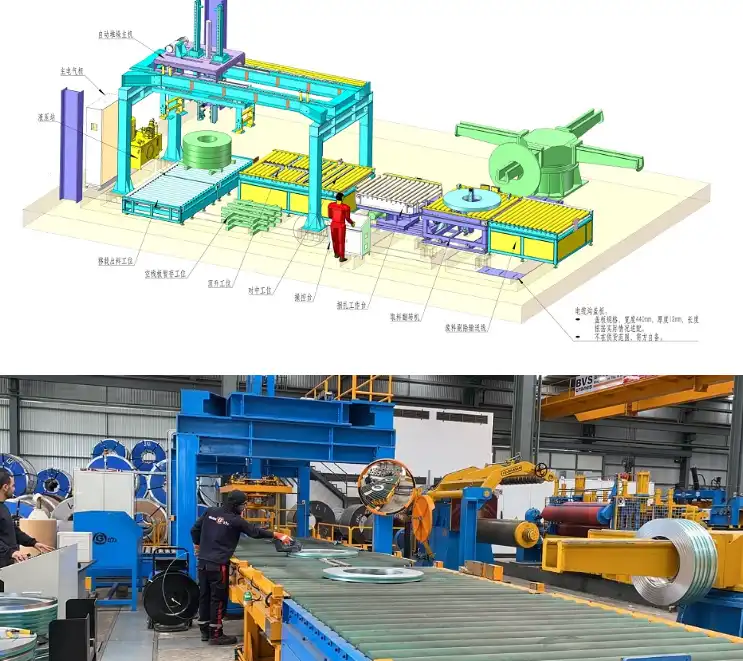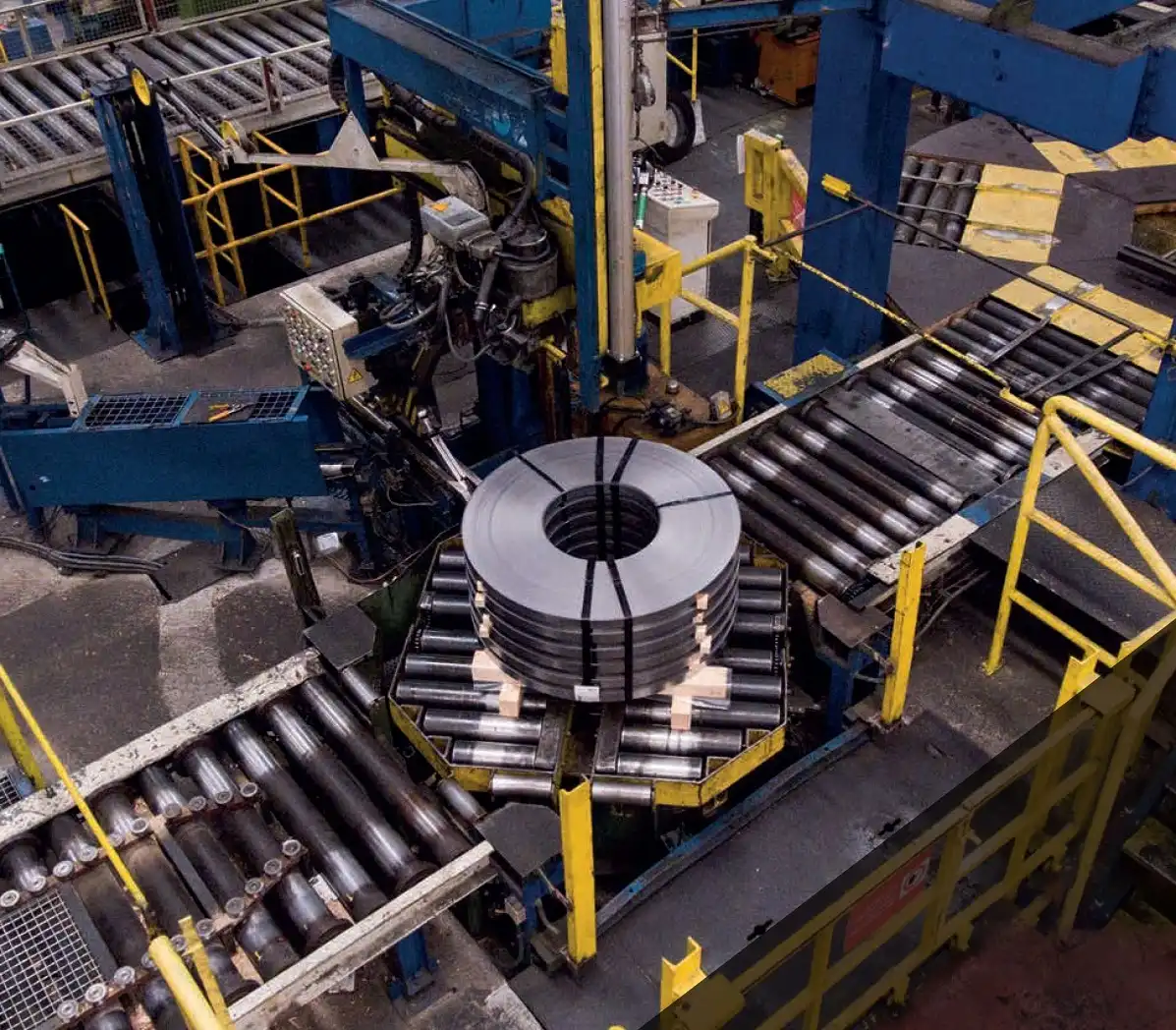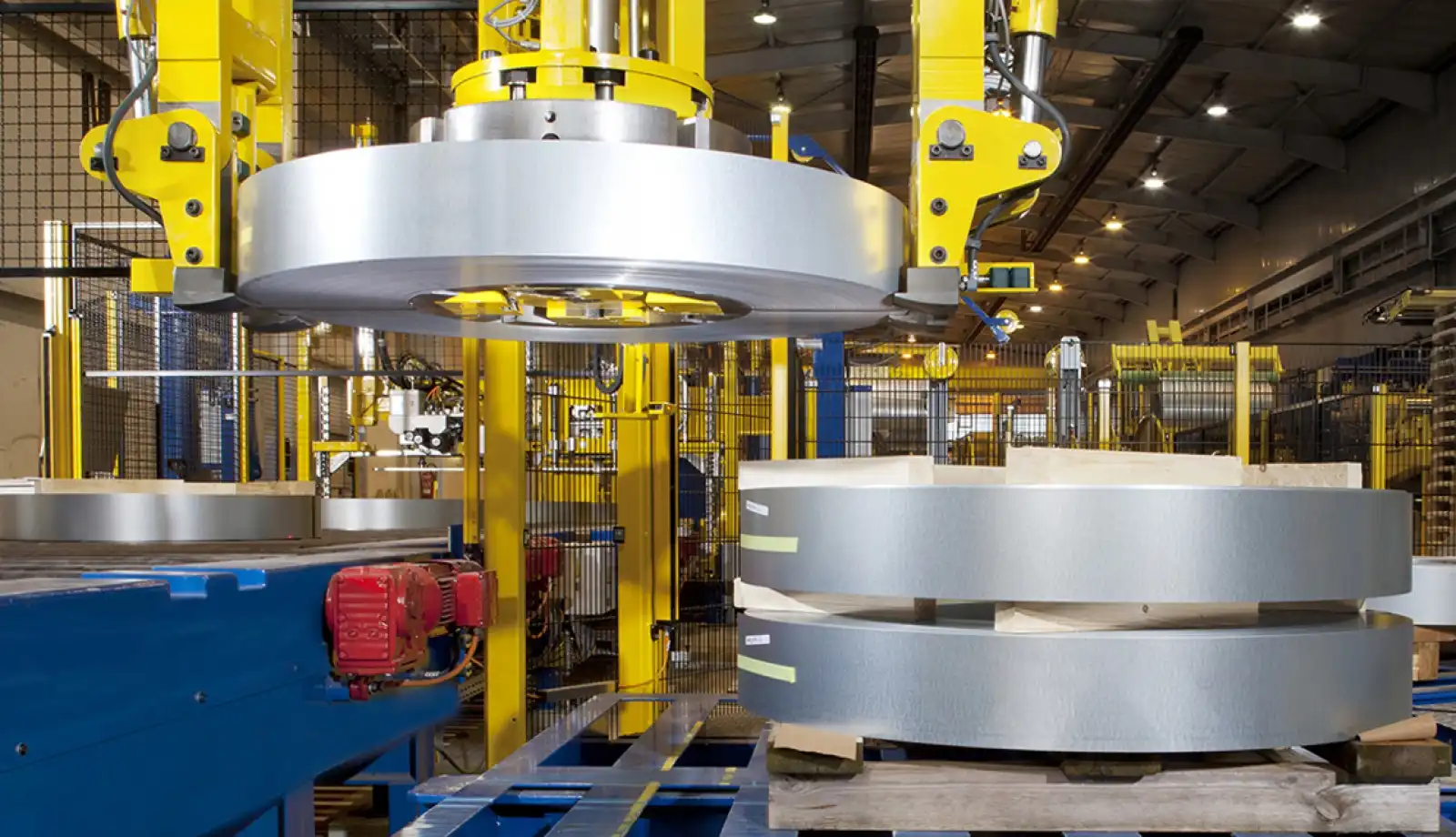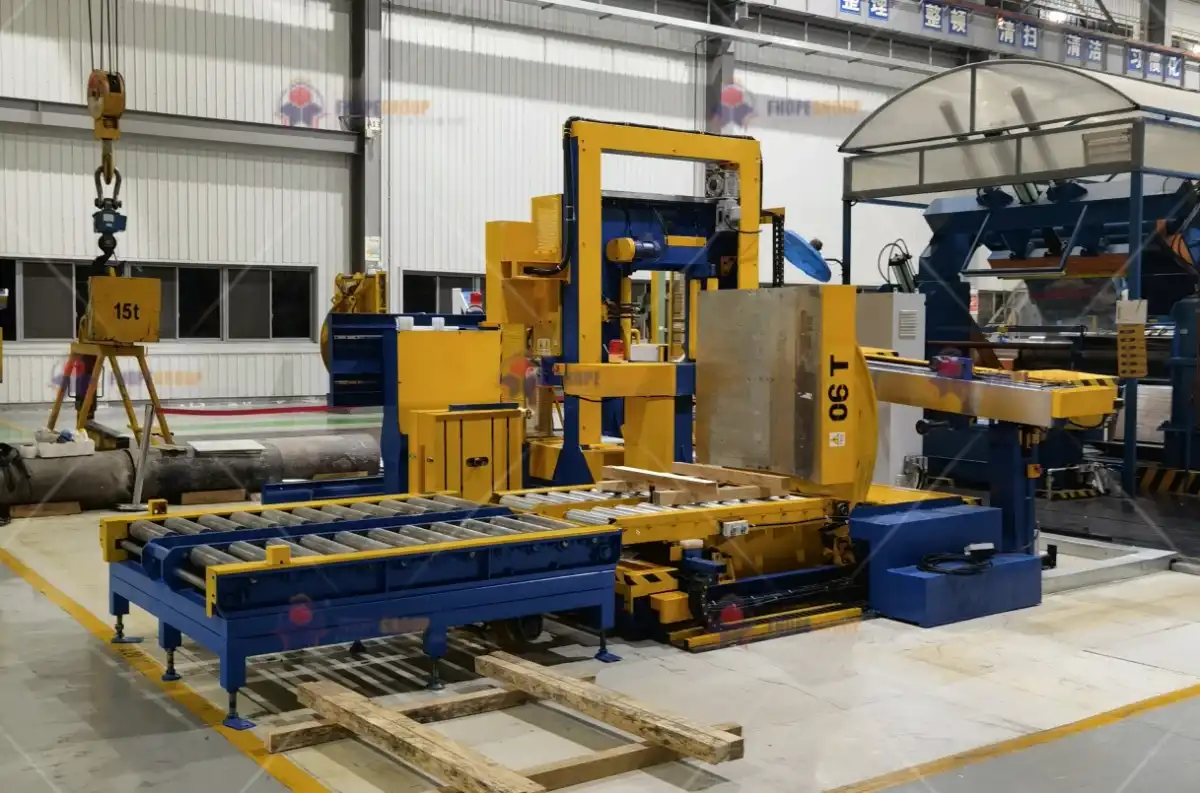You run a massive operation. Every day, you are under pressure to produce more, cut costs, and stay ahead of the competition. But aging equipment in your packaging area creates a bottleneck that can bring your entire production line to a halt. A single failure there can delay shipments, damage your reputation, and erase the profits you worked so hard to create elsewhere in the plant. This final step in your process shouldn't be a source of risk and frustration. It's time to transform your packaging line from a cost center into a strategic asset that drives efficiency and protects your bottom line.
The Return on Investment (ROI) for a modern coil packaging line is not just a theory; it's a measurable outcome. It is primarily generated from direct cost reductions in labor, significant decreases in packaging material waste, and the near-elimination of product damage during transit. Additionally, powerful indirect gains such as increased production throughput, a safer work environment, and enhanced customer satisfaction contribute to a payback period that is often between 18 and 36 months.

I have spent my entire career in the packing machine industry, first as an engineer on the factory floor and later as the founder of my own factory. I've seen firsthand how a well-designed packaging system can unlock hidden potential in a steel mill. This isn't just about buying a new machine. It's about making a calculated investment in your plant's future. Let's break down how this investment pays off, piece by piece.
How Can Modern Coil Packaging Lines Reduce Downtime and Boost Utilization?
Your old packaging line keeps breaking down at the worst possible moments. These unexpected stops create chaos on the production floor. They cause bottlenecks that ripple backward through the entire line, forcing other machines to sit idle. This lost time destroys your production schedule, leads to late shipments, and puts a strain on your team. Modern automated systems are engineered specifically to solve this problem, providing the reliability you need to run a smooth, continuous operation.
A modern coil packaging line directly reduces downtime by using robust, heavy-duty components and integrated diagnostic systems that monitor machine health in real time. Features like quick-change parts and remote troubleshooting capabilities mean that if a stop does occur, it can be resolved in minutes, not hours. This dramatic increase in equipment availability is a key factor in boosting your overall plant utilization toward your goal of 95%.

Deconstructing Downtime's True Impact
When a machine goes down, the cost is far more than just the parts and labor for the repair. I learned this lesson the hard way early in my career. A client's aging wrapper failed, and it took two days to get a specific part. The cost of that part was a few hundred dollars. But the cost of the shutdown was tens of thousands in lost production, idle labor costs, and penalties for a late shipment to a major automotive customer. The true cost of downtime is often hidden. We need to look at the entire picture to understand the value of reliability.
| Downtime Cost Factor | Description | Typical Financial Impact (per hour) |
|---|---|---|
| Lost Production | The value of the coils that were not packaged and shipped. | $5,000 - $20,000+ |
| Idle Labor | Wages and benefits for operators who are unable to work. | $200 - $500 |
| Supply Chain Disruption | Costs of rescheduling trucks, potential late delivery fees. | $100 - $1,000 |
| Maintenance Overtime | Higher labor costs for emergency repairs outside of normal hours. | $100 - $300 |
Features Designed for Maximum Uptime
A modern packaging line is not just a collection of parts; it is an integrated system designed for continuous operation. When we design a machine at SHJLPACK, reliability is our primary focus. We achieve this through several key design philosophies. First, we use heavy-duty, welded steel frames that can withstand the demanding environment of a steel mill. Second, we only use world-class components like Siemens PLCs and Schneider drives. These parts have a proven track record of reliability and are readily available worldwide. Third, we incorporate features for proactive maintenance. This includes centralized lubrication points, easy-access panels, and modular designs. For example, a wrapping shuttle or a strapping head can be swapped out quickly, turning a potentially day-long repair into a one-hour job. Finally, we build in remote diagnostic capabilities. Our engineers can log into your machine from our office to help your team diagnose a problem instantly, saving you from waiting for a technician to travel to your site. These features combined attack downtime from every angle.
What are the Hidden Energy and Material Savings in Automated Wrapping Systems?
You watch your energy and material bills climb higher every month. It feels like a battle you can't win. Every extra meter of stretch film used, every unnecessary scrap of VCI paper, and every kilowatt-hour of electricity consumed by an inefficient motor eats directly into your profit margins. Manual processes are full of this kind of waste. An automated system, however, brings a level of precision and efficiency that is impossible to achieve by hand, turning that waste into tangible savings.
Automated coil wrapping systems generate substantial savings by using advanced technology to control the consumption of packaging materials and energy. For instance, a powered pre-stretch carriage can reduce stretch film usage by over 50% by stretching the film before it is applied to the coil. Similarly, the system uses sensors to apply exactly the right amount of VCI paper or other materials, eliminating guesswork and waste. They also incorporate energy-efficient motors with variable frequency drives (VFDs) that only draw significant power when the machine is actively working, drastically cutting idle energy consumption.

Unlocking Material Savings Through Precision
The single biggest source of material savings in a packaging line is the control of stretch film. When I first started visiting factories, I would see workers wrapping massive steel coils by hand. They would pull the film as hard as they could, but they could only get about 10-20% stretch. A modern automated wrapper has a powered pre-stretch carriage. This feature uses two rollers rotating at different speeds to stretch the film by 200% to 300% before it even touches the coil. This means that one meter of film off the roll becomes three or four meters of applied film. The film becomes stronger and provides better load containment, all while using less material.
| Feature | Manual Wrapping | Automated Wrapping | Savings |
|---|---|---|---|
| Stretch Film Usage | 10-20% stretch | 250% pre-stretch | 50-70% reduction |
| VCI Paper/Wrap | Manual cutting, overlap guesswork | Sensor-based, precise application | 15-25% reduction |
| Strapping | Inconsistent placement | Optimized, automatic placement | 5-10% reduction |
Driving Down Energy Consumption
Your goal to reduce unit energy consumption by 10% is absolutely achievable, and your packaging line can be a major contributor. Older machines, especially those using hydraulics, are notoriously inefficient. The hydraulic pump often runs continuously, consuming a large amount of electricity even when the machine is idle between coils. A modern, all-electric design changes this completely. We use high-efficiency electric motors equipped with Variable Frequency Drives (VFDs). A VFD allows the motor to ramp up its speed and power consumption only when needed for a specific task, like lifting a coil or rotating the wrapping ring. When the machine is waiting for the next coil, it enters a low-power "sleep" mode. This intelligent use of energy can reduce the packaging line's electricity consumption by as much as 40-60% compared to an older hydraulic model, directly supporting your plant-wide energy reduction goals.
How Do You Calculate the True ROI of a New Coil Packaging Machine?
Investing in a new packaging line is a major capital decision. As a business owner, you need to be certain that the numbers will work and that the investment will deliver a strong return. It's easy to focus only on the initial purchase price, but that is a mistake. A low-cost machine with high operating expenses can cost you far more in the long run. To make the right decision, you must analyze the full financial picture. I can show you the same practical method I use to help my clients justify their investments.
To calculate the true ROI of a coil packaging machine, you need to add up all the annual cost savings and revenue gains, then divide that total by the initial investment cost. This process requires a detailed look at tangible savings like reduced labor, material, and energy costs, as well as the financial value of less tangible benefits like improved safety, higher quality, and increased throughput. This comprehensive approach gives you the real payback period and a clear justification for the project.

Step 1: Document Your Current Annual Costs
The first step is to create a clear baseline. You need to know exactly what your current packaging process costs you each year. Be thorough. Many of these costs are hidden in different departmental budgets.
| Current Annual Cost Category | Calculation / Notes | Example Annual Cost |
|---|---|---|
| Labor Costs | (Number of Operators) x (Hours/Year) x (Hourly Wage + Benefits) | 3 operators x 2080 hours x $35/hr = $218,400 |
| Material Costs | Annual spending on stretch film, straps, paper, labels, etc. | $150,000 |
| Maintenance Costs | Parts and labor for repairs on the old machine. Include overtime. | $25,000 |
| Product Damage Costs | Value of goods damaged in transit due to poor packaging. | $30,000 |
| Workplace Injury Costs | Direct and indirect costs from manual handling injuries. | $15,000 (Average) |
| Total Annual Operating Cost | Sum of all above costs | $438,400 |
Step 2: Project Your Future Annual Costs
Now, let's project the costs with a new, automated system. Automation will reduce costs across the board. The machine supplier should be able to help you estimate these savings based on the new system's capabilities.
| Future Annual Cost Category | Projected Savings | Example Annual Cost |
|---|---|---|
| Labor Costs | Reassign 2 of 3 operators. (1 operator x 2080 hours x $35/hr) | $72,800 |
| Material Costs | 50% reduction in film, 20% in other materials. | $80,000 |
| Maintenance Costs | New machine under warranty, minimal maintenance. | $5,000 |
| Product Damage Costs | 90% reduction due to consistent, secure packaging. | $3,000 |
| Workplace Injury Costs | 95% reduction by eliminating manual tasks. | $750 |
| Total Future Operating Cost | Sum of all above costs | $161,550 |
Step 3: Calculate the ROI
With these figures, the calculation is straightforward.
- Annual Savings: $438,400 (Current Cost) - $161,550 (Future Cost) = $276,850
- Total Investment: Let's assume the new line costs $450,000 (installed).
- Simple ROI: ($276,850 / $450,000) = 61.5%
- Payback Period: ($450,000 / $276,850) = 1.62 Years
This is the kind of strict, data-driven analysis that turns a gut feeling into a solid business case. An investment that pays for itself in under two years while also improving safety and quality is a powerful strategic move.
How Does Integrating a Packaging Line with MES and IoT Drive Real-Time Decisions?
Right now, your packaging area might feel like a "black box." You have detailed data from your production and scheduling systems, but once a coil reaches the end of the line, that visibility disappears. You cannot truly optimize your entire operation when a critical final step is disconnected from your digital ecosystem. This lack of information makes it impossible to track performance, pinpoint inefficiencies, and achieve your goal of comprehensive production visualization. Modern packaging lines are not standalone machines. They are designed to be intelligent, data-generating nodes within your smart factory.
Integrating a new coil packaging line with your Manufacturing Execution System (MES) and plant-wide IoT network transforms it into a source of valuable, real-time data. When a coil arrives, the MES can automatically tell the packaging line the coil's ID, its specifications, and the customer's specific packaging requirements. The packaging machine then executes the correct wrapping "recipe" without human intervention and reports back key data—such as cycle time, materials consumed, and completion status—directly into your system. This creates a seamless flow of information, providing complete product traceability and enabling data-driven decisions.

From a "Dumb" Machine to a "Smart" Asset
When I started in this business, machines were purely mechanical. An operator pushed a button. Today, a packaging line is a sophisticated piece of computerized equipment. The integration with your factory's "brain" (the MES) is what unlocks its true potential. Here is how that connection works in a practical sense. An overhead crane or AGV places a coil at the entry point of the packaging line. A scanner reads the barcode or QR code on the coil. This ID is sent to the MES. The MES looks up the coil ID in its database and finds the associated customer order and packaging specification. It then sends a command back to the packaging line's PLC. The PLC receives the command—for example, "Recipe #17: two layers of VCI paper, three layers of stretch film, four radial straps." The machine then executes this recipe perfectly. This closed-loop communication eliminates human error and ensures every coil is packaged exactly as required.
The Power of Real-Time Data
This digital integration does more than just prevent errors. It provides a stream of data that helps you manage your entire operation more effectively. This is essential for achieving the kind of comprehensive production visualization and efficiency you are aiming for.
| Data-Driven Benefit | Impact on Your Operations |
|---|---|
| Full Traceability | Every packaging step for every coil is logged. If a customer has a quality issue, you can instantly pull the record showing how it was packaged, with what materials, and when. |
| Real-Time OEE | You can see the Overall Equipment Effectiveness (OEE) of your packaging line on your dashboard. This helps you instantly identify and address bottlenecks that affect throughput. |
| Inventory Automation | As soon as the machine reports a coil is finished, your ERP or warehouse management system can be updated automatically, improving inventory accuracy and logistics planning. |
| Predictive Maintenance | IoT sensors on the machine tracking motor temperature, vibration, and cycle counts feed data into your maintenance system, alerting you to potential failures before they cause downtime. |
This level of integration is no longer a futuristic concept; it is a core requirement for a modern, competitive steel operation. When you look for a new packaging line, you shouldn't just be asking about its mechanical speed. You should be asking about its ability to connect, communicate, and contribute to your digital transformation strategy.
My Insights
To Javier, and to every steel mill owner and CEO who shares your vision: I understand your journey. I started my career on the factory floor, learning the mechanics of these machines firsthand. Later, I took the risk of building my own factory from the ground up. I know the pressure of making payroll, the frustration of unexpected equipment failures, and the constant drive to find a competitive edge. Your challenges with volatile costs, aging machinery, and environmental regulations are the same challenges my most successful clients are tackling head-on.
Your goals are not just ambitious; they are essential. Achieving 95% utilization, cutting energy use by 10%, and reducing overall costs are the markers of a world-class operation. You are right to believe that digital transformation and strategic equipment investments are the way to get there.
The coil and wire packing industry gave me everything. It allowed me to achieve financial independence and to build a business I am proud of. Now, my mission with SHJLPACK is to give back. I want to share the knowledge I have gained over decades to help leaders like you succeed. A packaging line is more than just a machine at the end of your process. It is a critical investment in the efficiency, quality, and profitability of your entire operation. Let's make sure it is a strategic one.
Conclusion
Investing in modern coil packaging is a direct investment in your plant’s efficiency, resilience, and future profitability. Let's work together to build that stronger, more efficient future.




